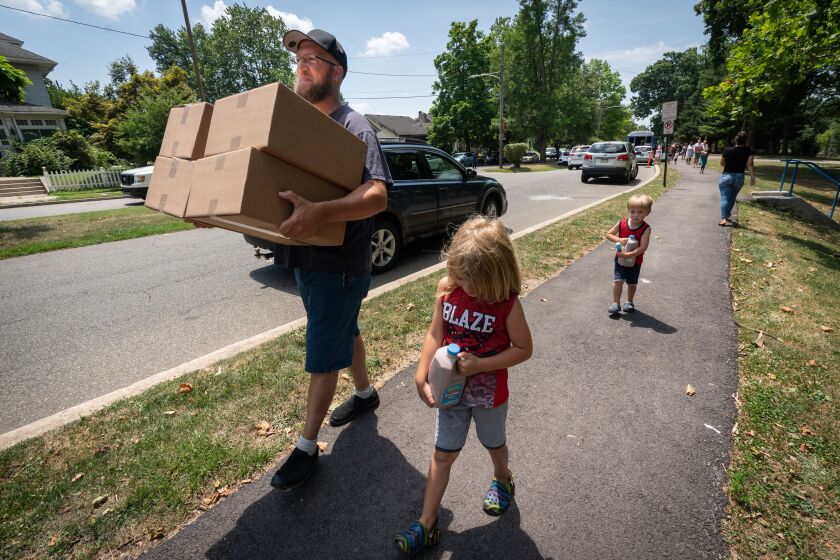Since May, many enrolled in the Food Distribution Programs on Indian Reservations (FDPIR) and commodity food programs for seniors have faced such shortages. Delayed, incomplete or missing deliveries increased after the U.S. Department of Agriculture switched to a single distribution and warehouse provider for all organizations providing food through the programs.
The USDA acknowledged the delays in a statement on Aug. 12, stating that the agency “recognizes this is a significant disruption that has left locations without acceptable inventories of necessary food items.”
The agency announced it would offer $11 million in cash assistance to help address food shortages caused by the agency’s decision to consolidate the supply chain. The funding amount for providers will depend on the number of clients they serve and their level of food needs, according to a USDA spokesperson.
More than 50,000 people rely on the federal program for food each month, an alternative to the Supplemental Nutrition Assistance Program, which can be hard to access in tribal jurisdictions.
“These are our families that we feed and the not knowing, the lack of communication, the lack of solution [is] unbearable,” said Mary Greene-Trottier, director of the Spirit Lake Nation Food Distribution Program. She said she hopes the USDA funding alleviates short-term needs, but is still concerned about ongoing disruption of deliveries.
In April, when the distribution system transitioned solely to the Missouri-based contractor Paris Brothers, it lacked staff and infrastructure to adequately communicate and coordinate orders. Throughout the months of May, June and July, program directors could not obtain confirmation that their monthly orders had been received, even after persistent follow-up, they reported.
Many shipments arrived incomplete or weeks after scheduled delivery dates, with little to no communication about delays, they said. Paris Brothers has not responded to requests for comment.
The Omaha Nation Food Distribution Program in Nebraska gets a truck on the first Thursday of every month with frozen meats, canned goods, pasta and cheese. In April, the program received an email from USDA suggesting that it would not be able to place orders for the month of May while the vendor established the centralized warehouse system.
Marisa Fuller, director of the Omaha Nation Food Distribution Program, said, “We cannot go a whole month without food. … Our people cannot go without food.”
‘A Vital Program’
More than 25 percent of Native American households face food insecurity. “FDPIR is a vital program because we’ve had participants that this is their only food source,” Fuller said.
In February, USDA’s Food and Nutrition Service announced that the warehouses supplying the FDPIR and the Commodity Supplemental Foods Program for those 60 years and older would be consolidated and served by a single distribution provider, Paris Brothers.
That same month, tribal leaders expressed concern about the switch and questioned whether a phased-in, gradual transition would be feasible. Fuller said that instead, during the call, officials “assured us that everything was going to be OK, there was going to be no disruption.”
For tribal leaders, “the potential for a disruption like this was very much on everyone’s radar,” said Carly Griffith Hotvedt, interim executive director of the Indigenous Food and Agriculture Initiative, an advocacy group.
Spirit Lake Nation’s food program gets deliveries every other week from the national supplier and a weekly produce delivery with fresh eggs. In mid-August the program was about to run out of beans, juices, frozen fruits, canned soups and noodles. At the start of August, Griffith Hotvedt said, deliveries increased, but haven’t made up for the significant backlog. A USDA spokesperson said the agency was prioritizing sites with the least food.
The Commodity Supplemental Foods Program, which supplies food for 725,000 lower-income seniors, has also experienced some disruptions because of the warehouse consolidation. The Bismarck chapter of the Great Plains Food Bank had a weeklong delivery delay in July, Chief Operating Officer Kate Molbert said.
The state of North Dakota and Feeding America alerted the Great Plains Food Bank in June that nutrition assistance programs may be facing delays. Molbert said the organization has remained in communication with local tribal partners to see if there were resources it could provide.
What Advocates Want
The Indigenous Food and Agriculture Initiative works closely with a coalition of FDPIR programs. In May, when it began hearing of delays, the organization started identifying the most at-risk programs and asking how it could help. The organization connected some groups with Feeding America, a national nonprofit food bank program.
Some distribution programs discussed sending their own trucks to retrieve supplies or using tribal funds that could be reimbursed later, Greene-Trottier said. Some tribal members unenrolled from FDPIR and signed up for SNAP benefits, despite the challenges of accessing the program. One option floated was activating the Emergency Food Assistance Program, another USDA program. But state agencies would need to declare a disaster to access those.
“We recognize the impact these delays are having on the daily lives of FDPIR and CSFP participants, including their families and communities, and we are deeply committed to finding solutions for the immediate term while addressing underlying issues,” stated a USDA spokesperson in an email.
Griffith Hotvedt emphasized that programs like FDPIR serve the most vulnerable populations, including children and elders.
Tribal leaders want to see consistent communication from USDA. The Indigenous Food and Agriculture Initiative is exploring policy changes to prevent this in the future.
“We’ve built a good rapport with our participants and our community, even our non-Native folks that we serve; they’re very understanding of what’s taking place,” Fuller said.
This article was first published by Buffalo's Fire. Read the original here.
Related Articles












